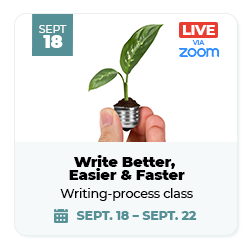Model the Masters to polish your own writing
The history of writing is the story of Modeling the Masters:

“Hemingway studied as models the novels of Knut Hamsun and Ivan Turgenev,” writes author Annie Dillard in The Writing Life. “Ralph Ellison studied Hemingway and Gertrude Stein. Thoreau loved Homer; Eudora Welty loved Chekhov. Faulkner described his debt to Sherwood Anderson and Joyce; E.M. Forster, his debt to Jane Austen and Proust.”
What could you learn by Modeling the Masters, or finding mentors while reading your own favorite communications?
Don’t just read as a reader.
To Model the Masters, read as a writer, not just as a reader. Readers read for information and entertainment. Writers read for information and entertainment, too. But they also read for something else: technique.
Dip into your clips and riff off your favorite passages.
How do you separate your reader from your writer so you can find new techniques?
1. Move from your pleasure-reading spot.
I do my writer-reading on planes and at my desk. I read as a reader on my couch or in bed. Where’s the best spot for you to read as a writer?
2. Gather the right tools
Reading like a writer used to take highlighters, pencils and sticky notes. Now I use my Kindle app’s highlight features to capture great passages.
3. Don’t get swept away.
Don’t get lost in the prose. When you feel this happening, force yourself to snap out of it and focus again on technique.
4. Create a clip file.
While you’re reading, look for passages to save and study. Every time you hear yourself saying, “I wish I’d written that,” “that” goes into your clip file. Then, when you need ideas or inspiration, you can dip into your clips and riff off of one of your favorites.
One of the passages in my clip file is:
When I invited participants in a workshop to model that passage, one PR agency’s accountant — the accountant! — modeled that passage to come up with this sentence:
If an accountant (did I mention it was the accountant?!) can come up with that passage by Modeling the Masters, imagine what you can do!
Work with — not against — your brain
While we talk a lot about what to write — More stories! Fewer words! Shorter sentences! — we don’t focus so much on how.

Writing is hard because we weren’t taught how to write. Instead, we were taught how to edit: how to spell, punctuate and use the right grammar.
But there is a how to writing. Learn a few simple steps that will make your writing time more effective and efficient at How to write Better, Easier & Faster — our writing-process workshop starting Sept. 18.
You’ll learn to invest your time where it’ll do you the most good … stop committing creative incest … even save time by editing before writing.
Save up to $100 with our group discounts.
